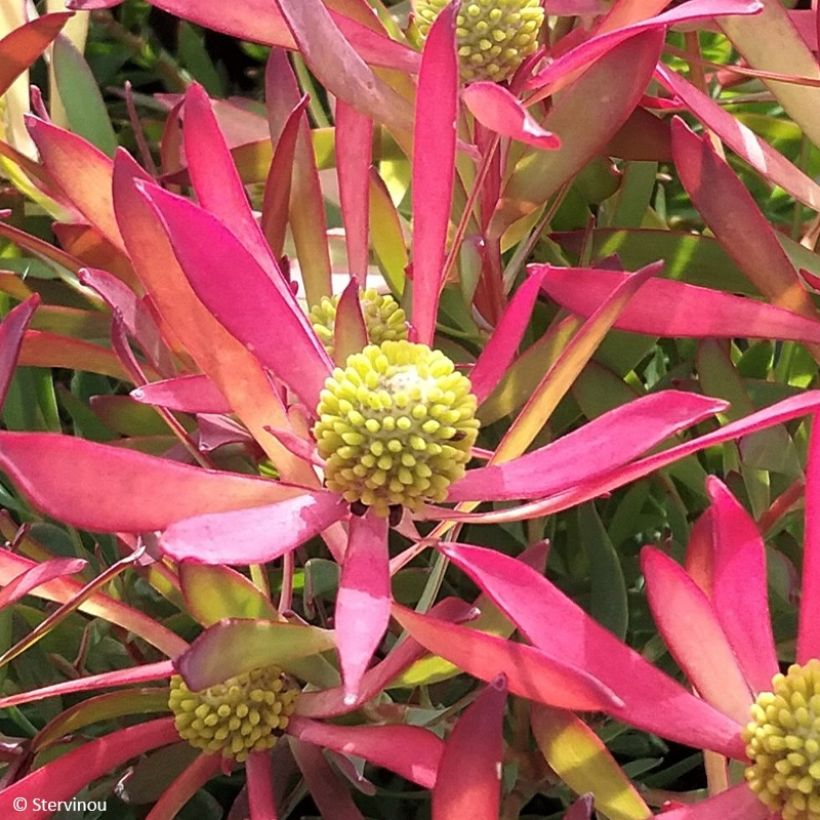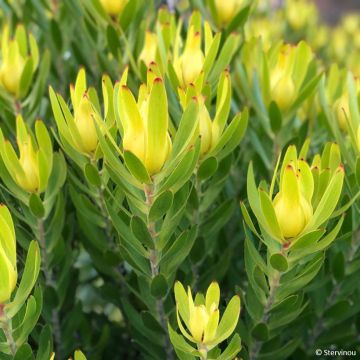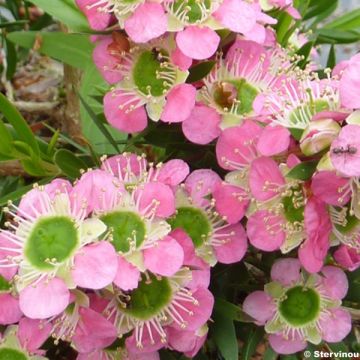

Leucadendron Cheeky
Leucadendron salignum Cheeky - Conebush
Leucadendron x salignum Cheeky
Conebush
Hello, My young plant has become completely dried out. Is there any hope of saving it? Thank you.
Chantal, 26/07/2022
Special offer!
Receive a €20 voucher for any order over €90 (excluding delivery costs, credit notes, and plastic-free options)!
1- Add your favorite plants to your cart.
2- Once you have reached €90, confirm your order (you can even choose the delivery date!).
3- As soon as your order is shipped, you will receive an email containing your voucher code, valid for 3 months (90 days).
Your voucher is unique and can only be used once, for any order with a minimum value of €20, excluding delivery costs.
Can be combined with other current offers, non-divisible and non-refundable.
Why not try an alternative variety in stock?
View all →This plant carries a 24 months recovery warranty
More information
We guarantee the quality of our plants for a full growing cycle, and will replace at our expense any plant that fails to recover under normal climatic and planting conditions.
Would this plant suit my garden?
Set up your Plantfit profile →
Description
Leucadendron Cheeky is a small evergreen bush of South African origin, close to the intensely exotic looking Proteas, sensitive to cold and slightly delicate to grow. It is a particularly attractive garden plant when the soil and climate are conducive to its cultivation, but also a leading greenhouse plant. This Cheeky variety is characterised by a compact habit and remarkably colourful flowering formed of bright red bracts surrounding a small golden yellow cone. Increasingly used in contemporary or Mediterranean inspired designs - in beds or as standalone plants, particularly by the sea - Leucadendrons require poor, perfectly drained soil and a very sunny site to thrive. Cultivation in large pots is preferable outside the mildest areas; it ise imperative to store the plant away as soon as the first frosts arrive.
Leucadendron Cheeky is from the Proteaceae family, resulting from cross-breeding with Leucadendron salignum, a species found in the Cape Province of South Africa. Like Proteas, Leucadendrons are strange plants in every respect, and need fire to germinate their seeds. Unlike Proteas however, the male and female plants are distinct. 'Cheeky' is a male cultivar. It forms a small and dense bushy shrub with a compact habit. This variety quickly reaches 60 cm (24 in) in height and 1 m (3 in) in diameter. Multiple stems emerge from a stump capable of regenerating after a fire. They bear narrow and long, elliptical green leaves, covered with a waxy bloom in winter and sometimes also in summer. Flowering generally takes place from February to April in our climates. The small flowers, arranged in more or less conical inflorescences, bright yellow in colour, are surrounded by long very conspicuous red bracts, arranged in stars. They colour from the winter, before the appearance of the inflorescences, giving the whole a flamboyant aspect in winter.
Leucadendron Cheeky is a sensational plant for very mild climates. It will establish in coastal gardens spared from severe frosts, in light, poor, mineral, rather acidic soil. It is particularly suited to a Mediterranean climate with long summers. It will look good as a standalone plant, on large slopes or at the back of exotic flowerbeds, but always in an open situation, in full sun. In an exotic garden it can be combined with plants that appreciate the same growing conditions: the Canary Viperine, the Royal Protea, Grevilleas, Coastal Banksia, or the Fire Tree of Chile for example. In South Africa, the flowers are highly appreciated in floristry as they last a long time in bouquets while bringing fantastic colour.
Report an error about the product description
Leucadendron salignum Cheeky - Conebush in pictures




Plant habit
Flowering
Foliage
Botanical data
Leucadendron
x salignum
Cheeky
Proteaceae
Conebush
Cultivar or hybrid
Other Leucadendron
View all →Planting and care
Plant Leucadendron 'Cheeky' in spring, or in the autumn in very mild climates, in a very sunny site sheltered from the wind. This plant requires light, well-drained, filtering soil, low in nitrogen, with an acidic tendency, moist to dry in summer. A mixture of leaf compost, a little ericaceous soil and a lot of river sand seems appropriate. Leucadendrons, like Proteas, are sensitive to excess phosphates and nitrates, so avoid giving them too much fertiliser, or even none at all, and in any case not organic fertiliser. While adult plants tolerate occasional frosts in the order of -5 °C in dry soil, young plants will need to be sheltered over winter during their first years - in a frost-free place in cool climates, or under a winter fleece in regions with mild winters. This plant flowers about 4 to 5 years after sowing. For indoor cultivation, it is important to maintain good room ventilation and avoid watering with hard water as much as possible.
Planting period
Intended location
Care
-
, onOrder confirmed
Reply from on Promesse de fleurs
Similar products
Haven't found what you were looking for?
Hardiness is the lowest winter temperature a plant can endure without suffering serious damage or even dying. However, hardiness is affected by location (a sheltered area, such as a patio), protection (winter cover) and soil type (hardiness is improved by well-drained soil).

Photo Sharing Terms & Conditions
In order to encourage gardeners to interact and share their experiences, Promesse de fleurs offers various media enabling content to be uploaded onto its Site - in particular via the ‘Photo sharing’ module.
The User agrees to refrain from:
- Posting any content that is illegal, prejudicial, insulting, racist, inciteful to hatred, revisionist, contrary to public decency, that infringes on privacy or on the privacy rights of third parties, in particular the publicity rights of persons and goods, intellectual property rights, or the right to privacy.
- Submitting content on behalf of a third party;
- Impersonate the identity of a third party and/or publish any personal information about a third party;
In general, the User undertakes to refrain from any unethical behaviour.
All Content (in particular text, comments, files, images, photos, videos, creative works, etc.), which may be subject to property or intellectual property rights, image or other private rights, shall remain the property of the User, subject to the limited rights granted by the terms of the licence granted by Promesse de fleurs as stated below. Users are at liberty to publish or not to publish such Content on the Site, notably via the ‘Photo Sharing’ facility, and accept that this Content shall be made public and freely accessible, notably on the Internet.
Users further acknowledge, undertake to have ,and guarantee that they hold all necessary rights and permissions to publish such material on the Site, in particular with regard to the legislation in force pertaining to any privacy, property, intellectual property, image, or contractual rights, or rights of any other nature. By publishing such Content on the Site, Users acknowledge accepting full liability as publishers of the Content within the meaning of the law, and grant Promesse de fleurs, free of charge, an inclusive, worldwide licence for the said Content for the entire duration of its publication, including all reproduction, representation, up/downloading, displaying, performing, transmission, and storage rights.
Users also grant permission for their name to be linked to the Content and accept that this link may not always be made available.
By engaging in posting material, Users consent to their Content becoming automatically accessible on the Internet, in particular on other sites and/or blogs and/or web pages of the Promesse de fleurs site, including in particular social pages and the Promesse de fleurs catalogue.
Users may secure the removal of entrusted content free of charge by issuing a simple request via our contact form.
The flowering period indicated on our website applies to countries and regions located in USDA zone 8 (France, the United Kingdom, Ireland, the Netherlands, etc.)
It will vary according to where you live:
- In zones 9 to 10 (Italy, Spain, Greece, etc.), flowering will occur about 2 to 4 weeks earlier.
- In zones 6 to 7 (Germany, Poland, Slovenia, and lower mountainous regions), flowering will be delayed by 2 to 3 weeks.
- In zone 5 (Central Europe, Scandinavia), blooming will be delayed by 3 to 5 weeks.
In temperate climates, pruning of spring-flowering shrubs (forsythia, spireas, etc.) should be done just after flowering.
Pruning of summer-flowering shrubs (Indian Lilac, Perovskia, etc.) can be done in winter or spring.
In cold regions as well as with frost-sensitive plants, avoid pruning too early when severe frosts may still occur.
The planting period indicated on our website applies to countries and regions located in USDA zone 8 (France, United Kingdom, Ireland, Netherlands).
It will vary according to where you live:
- In Mediterranean zones (Marseille, Madrid, Milan, etc.), autumn and winter are the best planting periods.
- In continental zones (Strasbourg, Munich, Vienna, etc.), delay planting by 2 to 3 weeks in spring and bring it forward by 2 to 4 weeks in autumn.
- In mountainous regions (the Alps, Pyrenees, Carpathians, etc.), it is best to plant in late spring (May-June) or late summer (August-September).
The harvesting period indicated on our website applies to countries and regions in USDA zone 8 (France, England, Ireland, the Netherlands).
In colder areas (Scandinavia, Poland, Austria...) fruit and vegetable harvests are likely to be delayed by 3-4 weeks.
In warmer areas (Italy, Spain, Greece, etc.), harvesting will probably take place earlier, depending on weather conditions.
The sowing periods indicated on our website apply to countries and regions within USDA Zone 8 (France, UK, Ireland, Netherlands).
In colder areas (Scandinavia, Poland, Austria...), delay any outdoor sowing by 3-4 weeks, or sow under glass.
In warmer climes (Italy, Spain, Greece, etc.), bring outdoor sowing forward by a few weeks.


















































